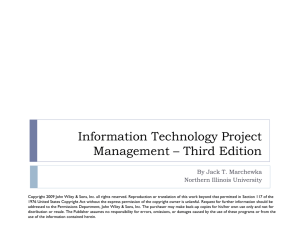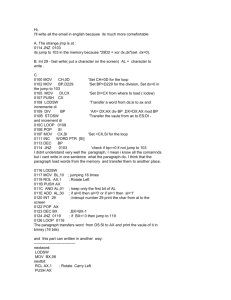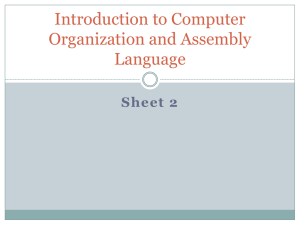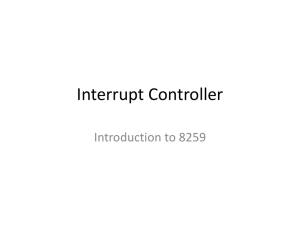Answer
advertisement
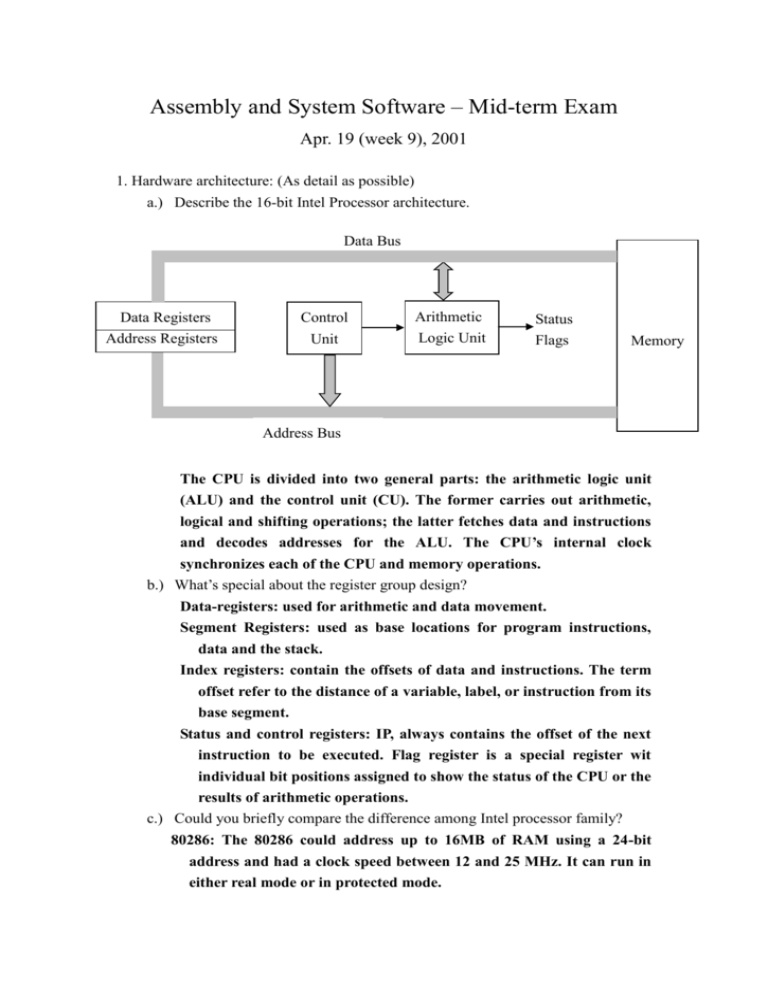
Assembly and System Software – Mid-term Exam Apr. 19 (week 9), 2001 1. Hardware architecture: (As detail as possible) a.) Describe the 16-bit Intel Processor architecture. Data Bus Data Registers Address Registers Control Unit Arithmetic Logic Unit Status Flags Memory Address Bus The CPU is divided into two general parts: the arithmetic logic unit (ALU) and the control unit (CU). The former carries out arithmetic, logical and shifting operations; the latter fetches data and instructions and decodes addresses for the ALU. The CPU’s internal clock synchronizes each of the CPU and memory operations. b.) What’s special about the register group design? Data-registers: used for arithmetic and data movement. Segment Registers: used as base locations for program instructions, data and the stack. Index registers: contain the offsets of data and instructions. The term offset refer to the distance of a variable, label, or instruction from its base segment. Status and control registers: IP, always contains the offset of the next instruction to be executed. Flag register is a special register wit individual bit positions assigned to show the status of the CPU or the results of arithmetic operations. c.) Could you briefly compare the difference among Intel processor family? 80286: The 80286 could address up to 16MB of RAM using a 24-bit address and had a clock speed between 12 and 25 MHz. It can run in either real mode or in protected mode. 80386: The address bus was increased to 32 bits, permitting programs to address up to 4GB of ram. It supported three modes of operation: real mode, protected mode and virtual mode. 80486: The first Intel processor to integrate the floating-point unit directly into the CPU chip. It has internal 8K high-speed level-1 cache memory that holds copies of instructions and data that have been most recently accessed. Pentium: It is able to execute more than one instruction per clock cycle because of it superscalar design with two instruction pipelines. It has a 32-bit address bus and a 64-bit internal data path. 2. Software architecture: a.) What’s the procedure when the computer’s OS is started up? The CPU jumps to an initialization program in the ROM BIOS. A program called the bootstrap loader loads the boot record from the drive that has been designated as the startup drive. The boot record contains a program that executes as soon as it is loaded. This program in turn loads io.sys and msdos.sys. The last program loaded into memory is the MS-DOS command processor, command.com b.) What is virtual address? How does the CPU address up to 1MB memory? Using segment-offset addressing. Segment value: 0 8 F 1 (0) Add the offset: 0100 Absolute address 09010 3. Read the following program. What are the final values in the AX and BX registers? a.) A 100 b) A 100 mov ax, 1234 mov ax, 6BFF mov bl, al mov bh, ah add bx, 03C6 mov [250], ax mov bx, [250] inc bx AX=1234, BX = 15FA AX = 6BFF, BX = 6C00 4. Which of the following registers cannot be used as destination operands? AX, CL, IP, DX, CS, BH, SS, SP, BP CS, IP cannot be used as destination operands 5. There are three basic types of operands: immediate, register, and memory. There are six types of memory operands: direct, direct-offset, register-indirect, indexed, based-indexed, based-indexed with displacement. As each of the following instruction is executed, specify what type of operand is used, immediate or memory? What are the values of destination register (in hex)? If it is a memory operand, what is the effective address? If the instruction is illegal, indicates why? .data count db 2 wordList dw 0003h, 2000h array db 0Ah, 0Bh, 0Ch, 0Dh endlist label byte acc dw endlist .code Mov si, 1 Mov ax,[si] Mov bx, ax Mov al, array[bx] Add al, count Mov ax, (40*50) SUB ax, wordList+1 Mov ax, offset wordlist Mov al, array+2 Immediate register indirect Register Based Direct Immediate Direct-offset Direct Direct-offset SI=1 AX=0003 EA=1 BX=0003 AL=0D EA=05+03=08 AL=0F(d+2) EA=0 AX=07D0 AX=07D0 EA=0 AX=0001 EA=1 AL=0C EA=05+02=07 Mov al, endlist – 1 Direct-offset AL=0D EA=09-01=08 6. Correct any erroneous lines in the following program, based on the error messages printed by the assembler: 1: Title Find The Errors 2: 3. 4: .model .stack 100h 5: 6: 7: 8: 9: 10: 11: 12: 13: .code main small proc mov mov mov int main .data endp bl, val1 cx, val2 ax, 4C00h 21h 14: val1 db 10h 15: 16: val2 end dw 1000h main Assembler Error Message: (6): error A2062: Missing or unreachable CS (7): error A2086: Data emitted with no segment (8): error A2086: Data emitted with no segment (9): error A2086: Data emitted with no segment (10): error A2086: Data emitted with no segment 7. Describe the process when a software interrupt occurs. 1. The number following the INT mnemonic tells the CPU which entry to locate in the interrupt vector table. 2. The CPU jumps to the address stored in the interrupt vector table. 3. The interrupt handler begins execution and finishes when the IRET instruction is reached. 4. IRET cause the program to resume execution at the next instruction in the original calling program. 8. There are three levels of accessing video, what are they? What interrupt can be used? Describe as detail as possible. 1. Direct video access 2. BIOS-level access 3. DOS-level access In BIOS-level access, INT 10h function is used. Function number is from 00 to 11 setting in AH. In DOS-level access, INT 21h function is used with function number 02h, 06h, and 09h 9. On page 172, we have the factorial procedure as follows. a.) Please describe the operation on stack. 0feh 0fch 0fah 0f8h 0f6h 0f4h 0008 0007 0000 0007 0022 00FA n IP (return address) BP (n-1) IP (return address) BP 0f2h 0006 (n-2) 0f0h 0eeh b.) 0022 IP (return address) 00F4 BP Explain the reason what the instruction “RET 2” affect and why? The RET instruction adds 2 to SP, discarding the argument that was pushed on the stack. main proc 0000 mov ax, 8 0003 push ax 0004 call Factorial 0007 mov ax, 4C00h 000A int 21h main endp Factorial proc 000C 000D 000F 0012 0015 0017 001A push bp mov bp, sp mov ax, [bp+4] cmp ax, 1 ja L1 mov ax, 1 jmp L2 001D L1: dec ax 001E push ax 001F call Factorial 0022 mov bx, [bp+4] 0025 mul bx 0027 L2: pop bp 0028 RET 2 Factorial endp



